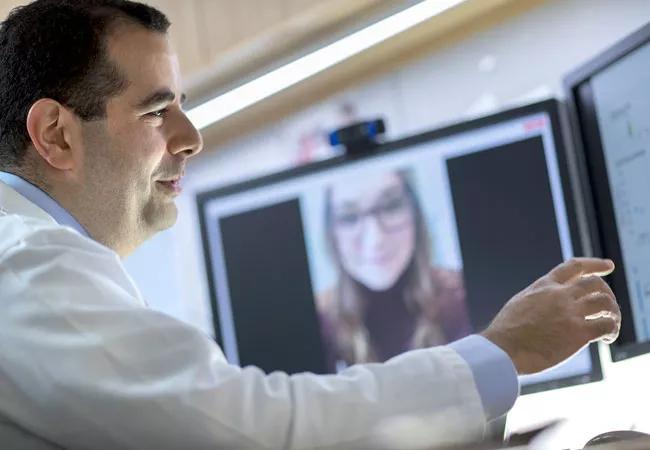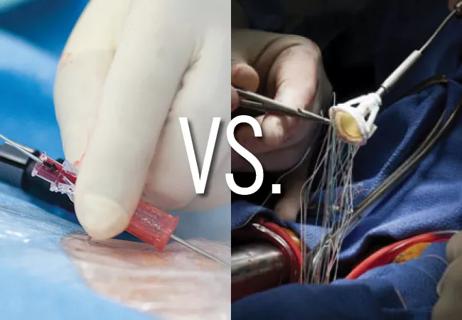Advertisement
Patient convenience fuels rollout of video-enabled remote care

As providers and patients increasingly embrace virtual visits, cardiac rhythm disorders are emerging as a natural starting point for telemedicine-enabled cardiovascular care at Cleveland Clinic.
Advertisement
Cleveland Clinic is a non-profit academic medical center. Advertising on our site helps support our mission. We do not endorse non-Cleveland Clinic products or services. Policy
“In electrophysiology, we depend heavily on the patient’s history and on direct conversation with the patient about his or her symptoms,” says Khaldoun Tarakji, MD, MPH (shown above), of the Section of Electrophysiology and Pacing. “This lends itself to video chat. When we add in data from the patient’s cardiac rhythm monitoring tools, we have most of what we need to care for most arrhythmia issues.”
That’s the reasoning behind Cleveland Clinic’s recent introduction of the option of telemedicine, rather than in-person, consultations with an electrophysiologist for established patients with heart rhythm disorders.
While electrophysiology is the first subspecialty to offer virtual visits for cardiovascular care at Cleveland Clinic, it’s not the first at the health system overall.
Cleveland Clinic’s Neurological Institute started the ball rolling by providing video-enabled “telestroke” consults to patients at some of the health system’s regional hospitals as well as outside hospitals. Additional Cleveland Clinic distance health services include 24/7 nonemergent care for selected conditions via the health system’s Express Care® Online app.
Distance health makes sense for a tertiary care center like Cleveland Clinic, says Dr. Tarakji, who leads the health system’s virtual electrophysiology effort. That’s because it attracts many patients from outside the region for second opinions and procedures — patients who often require periodic or frequent follow-up visits, which can pose hardships.
“Patients may lose a day or two of work for a one-hour visit,” says Dr. Tarakji. “And then there are issues of travel, accommodations, weather, parking and waiting.”
Enter the concept of a quick, simple video conversation to convert what could be a major travel ordeal and time commitment into a convenient consultation that the patient can take part in from home or the workplace.
Dr. Tarakji cites the example of an established patient from out of state whose atrial fibrillation had been controlled for several years before it suddenly returned. “We discussed the issue on video chat and determined that he would be best served with an ablation,” he explains. “The appointment was scheduled, and he came to Cleveland, but this time with a clear plan for a scheduled procedure. That eliminated the need for multiple long-distance trips for this patient.”
For a virtual electrophysiology consultation, the technology requirements at the provider’s end are minimal: two monitors placed side by side (as shown in the photo above), one with a mounted web camera.
To ensure privacy, Cleveland Clinic provides a secure, web-based telecommunications system enterprisewide. The system enables patients to access their physician’s “virtual waiting room” using the Cleveland Clinic Express Care Online app on their smartphone or tablet or a webcam on their personal computer.
Advertisement
At the appointed visit time, Dr. Tarakji simply logs on to the website and selects the patient’s name in his virtual waiting room and connects with the patient via real-time video exchange. On the other screen, he calls up the patient’s medical record and updates it during their conversation, “just like I would in the exam room,” he says.
Since his first virtual visit in early September 2016, Dr. Tarakji has “seen” more than a dozen patients via video chat. Other electrophysiologist colleagues are now gradually following in his footsteps.
He urges interested colleagues from other specialties to try it as well. “Some people are naturally apprehensive about new technology,” he says. “They wonder whether it will actually save time or just create more problems. But I would recommend at least trying it.”
“The patient feedback has been wonderful,” notes Dr. Tarakji. “When patients have worries, keeping the lines of communication open is reassuring. They know they are being taken care of. For us, it works beautifully.”
Yet Dr. Tarakji is quick to add that the days of traditional clinic visits are far from over. “Virtual visits don’t replace traditional visits in situations when it’s necessary to have direct contact with the patient,” he says. “Plus, there’s nothing better than human contact. But virtual visits represent a step forward when the alternative is losing the patient to follow-up.”
He adds that they’re also helping move medicine into the future: “Today we do everything online using smart devices. Medical practice needs to evolve and follow the same path.”
Photo credit: Russell Lee
Advertisement
Advertisement

Cleveland Clinic series supports its feasibility, especially with HeartMate 3

Questions remain following late mortality signal from a retrospective cohort study

TAVR explant demands multidisciplinary expertise

How two of our surgeons are working for care equity, greater representation in research and practice

Judicious application yields a 99.7% repair rate and 0.04% mortality

Studies reveal increased cardiac events, enhanced platelet reactivity and thrombotic potential

Large single-center series demonstrates safety and efficacy for extending procedure

Eminent clinician-researcher brings special expertise in nutritional interventions for heart failure